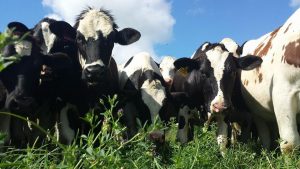 Pasture management research and innovation at the Pasture Dairy Center is aimed at providing producers with management techniques for successful utilization of forage from pastures. Keys to this success include routine measurement of forage availability, and use of the data collected to make informed decisions regarding pasture allocations and harvest of forage.
Pasture management research and innovation at the Pasture Dairy Center is aimed at providing producers with management techniques for successful utilization of forage from pastures. Keys to this success include routine measurement of forage availability, and use of the data collected to make informed decisions regarding pasture allocations and harvest of forage.
The Pasture Dairy Center manages 240 acres of pasture, including a 160 acre pasture surrounding the Robotic Milking Facility. This focal pasture area is divided into eight 20-acre, and each section is subdivided into eight grazing strips measuring 2.5 acres each. One hundred and twenty acres of pasture are currently used for the lactating cows, which is divided up into two farmlets (80 acres vs. 40 acres). These two farmlets are set up as a long term comparison of high (1.5 cow/acre) vs. low (1 cow/acre) stocking rate systems. The remaining 40 acres of pasture are currently devoted to forage variety testing and evaluation of forage crop rotations. Download information about the Farmlet Systems or a copy of the Pasture Dairy Center Paddock Map.
Pasture Species
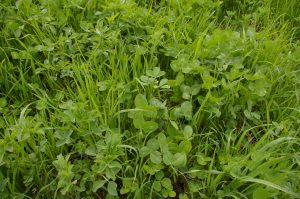 The perennial pastures are primarily one of two distinct cool season grass-legume mixtures. These include a high diversity mix (tall fescue, orchard grass, perennial ryegrass, alfalfa, red clover, birdsfoot trefoil, and white clover) and a low diversity mix (perennial ryegrass and white clover). Since different forage species have different growth and nutritional characteristics, planting a variety of forage species within the pasture can produce a more consistent forage supply during the grazing season, helping to ensure the health and productivity of both the plants and animals.
The perennial pastures are primarily one of two distinct cool season grass-legume mixtures. These include a high diversity mix (tall fescue, orchard grass, perennial ryegrass, alfalfa, red clover, birdsfoot trefoil, and white clover) and a low diversity mix (perennial ryegrass and white clover). Since different forage species have different growth and nutritional characteristics, planting a variety of forage species within the pasture can produce a more consistent forage supply during the grazing season, helping to ensure the health and productivity of both the plants and animals.
Pasture Measurements
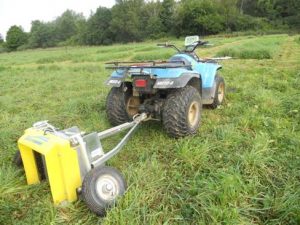 Measuring available pasture enables full utilization of pasture resources, allowing producers to make timely decisions for planning grazing rotations and identify potential feed surpluses or shortages. The available forage biomass is measured weekly to determine how much feed is available for the cows. Two methods of measuring pasture are used at the PDC. These include a C-dax Pasture Meter, which is a GPS referenced, laser measuring device that can be pulled behind an ATV, and the Rising Plate Meter.
Measuring available pasture enables full utilization of pasture resources, allowing producers to make timely decisions for planning grazing rotations and identify potential feed surpluses or shortages. The available forage biomass is measured weekly to determine how much feed is available for the cows. Two methods of measuring pasture are used at the PDC. These include a C-dax Pasture Meter, which is a GPS referenced, laser measuring device that can be pulled behind an ATV, and the Rising Plate Meter.
During the spring, forages grow faster than the cattle are able to harvest them. To manage this excess forage, a portion of the forage is harvested and stored as hay or silage. Harvesting excess forage during periods of excess growth provides feed for cattle during periods of the year when forage growth is slow or stopped. Additionally, timely harvesting maintains the nutritional quality of the forage by keeping the forage species in a vegetative state.
Grazing Season
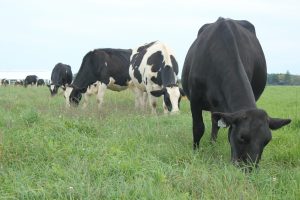 The grazing season is typically seven to eight months, running from April through November. The actual length of the grazing season varies from year to year depending on pasture growing conditions and available forage. When cattle are not able to graze, lactating cows are housed in the Robotic Milking Facility while replacement stock are housed in other barns. Winter diets are comprised of forages harvested from the pastures and other crops grown at the Kellogg Farm.
The grazing season is typically seven to eight months, running from April through November. The actual length of the grazing season varies from year to year depending on pasture growing conditions and available forage. When cattle are not able to graze, lactating cows are housed in the Robotic Milking Facility while replacement stock are housed in other barns. Winter diets are comprised of forages harvested from the pastures and other crops grown at the Kellogg Farm.
Irrigation
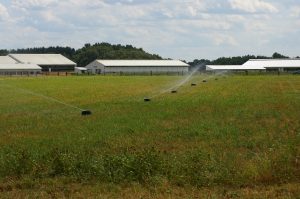 The 160 acres of pasture surrounding the Robotic Milking Facility are equipped with a portable K-line irrigation system. This system uses a low irrigation volume to reduce runoff and to facilitate water infiltration into the soil profile. Irrigation decision is based on accurate monitoring of soil moisture profiles using electro conductivity sensors. Irrigation is initiated when the soil moisture in the paddocks reaches less than 20%.
The 160 acres of pasture surrounding the Robotic Milking Facility are equipped with a portable K-line irrigation system. This system uses a low irrigation volume to reduce runoff and to facilitate water infiltration into the soil profile. Irrigation decision is based on accurate monitoring of soil moisture profiles using electro conductivity sensors. Irrigation is initiated when the soil moisture in the paddocks reaches less than 20%.
The system consists of a series of heavy duty polyethylene pods spaced at intervals along specially formulated polyethylene tubing. These lines of pods are designed to be moved by an ATV or small tractor along a predetermined route on a daily or as-desired basis.
Pasture management resources
- MSU Forage Connection web site provides a central hub of information on topics relating to forage production and grazing land use in Michigan. Forages and grazing lands, including pasture, hay, haylage, and silage, are the third most important agronomic crop in Michigan.
- MSU Department of Animal Science offers education and research for the safe, nutritious and economical production of animal food and fiber, and of animals for recreational purposes, without compromising the environment or jeopardizing the health and wellbeing and farm animals and farm communities.
- MSU Product Centerhelps Michigan entrepreneurs develop and commercialize high-value, consumer-responsive products and businesses in the agriculture, natural resources, and bioeconomy sectors. The Product Center is a single gateway to generating success for Michigan entrepreneurs.
- MSU Soil and Plant Nutrient Laboffers a variety of analytical services on samples of soil, composts, plant tissue, water and other materials related to the growing of plants (crops) received from commercial and part-time farmers, greenhouse operations, golf courses, homeowners, consultants, researchers, and others.
- University of Wisconsin Forage Research and Extensionmission: is to develop and disseminate information on the establishment, production, harvesting and storage of forages.
- Ohio State University Forage Network is a resource for forage information, news, research, and education.
- University of Minnesota Dairy Systems Dairy Extention team gives producers and industry professionals the tools they need to make sustainable and profitable decisions.
- University of Illinois PasturelLLINI Dairy NET is an online resource for the pasture industry.
- University of Missouri Dairyweb site contains the best source of practical dairy information targeted for Missouri’s dairy producers.
- Purdue University Forage Informationsite was designed to compile the most up-to-date forage information produced by Purdue University. Purdue Forage Information.
- American Forage and Grassland Council(AFGC) is dedicated to advancing the use of forage as a prime feed resource.
- University of Missouri Extensiondeveloped an online grazing wedge calculator for producers. The grazing wedge is a tool for managing feed on a pasture based dairy farm. It visually represents the quality and quantity of forage dry matter available both now and during the next round of grazing.
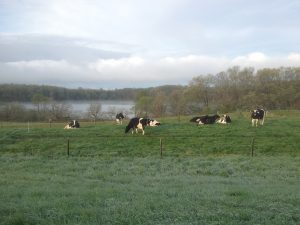 A well-managed grazing system has several environmental benefits. Along with soil conservation, perennial forages can build and improve soil quality by adding organic matter and increasing the ability to hold water and nutrients with root systems. This also helps reduce rain runoff, increase the water available to plants, and protect water-bodies. Legume forages such as alfalfa and clovers add nitrogen to the soil, a vital nutrient for living organisms. Because most forages are perennials, they provide long-term ground cover which limits the exposure of soil to wind and water and reduces erosion.
A well-managed grazing system has several environmental benefits. Along with soil conservation, perennial forages can build and improve soil quality by adding organic matter and increasing the ability to hold water and nutrients with root systems. This also helps reduce rain runoff, increase the water available to plants, and protect water-bodies. Legume forages such as alfalfa and clovers add nitrogen to the soil, a vital nutrient for living organisms. Because most forages are perennials, they provide long-term ground cover which limits the exposure of soil to wind and water and reduces erosion.
Growing consumer interest in dairy products with organic and grass-fed labels may provide a higher price for milk products from pasture dairies and provide incentives for small and new producers to adopt these practices. Pasture is a lower cost alternative to feeding stored feeds and cow longevity is often greater in pasture-based dairies than in confinement dairies. Lower feed costs and greater cow longevity help make pasture-based dairies a profitable option for smaller operations, even though milk production is typically reduced.

10461 N. 40th St.
Hickory Corners, MI 49060
(269) 671-2402
kelloggfarm@kbs.msu.edu